Time-Resolved FDTD and Experimental FTIR Study of Gold Micropatch Arrays for Wavelength-Selective Mid-Infrared Optical Coupling
Abstract
:1. Introduction
2. Materials and Methods
3. Transmittance, Reflectance, and Diffractance
- FDTD results of Figure 2a are for m under one polarized stimulation of . Since there is no reflection but perfect transmission for polarization, the reflectance and transmittance values for unpolarized stimulation at 4.2 m are expected to be 42% and 10%, respectively. Experimental Figure 2c are for m (80%, 4%) and (60%, 7%) under unpolarized stimulation. When we extrapolate the peak response values to m, we would get approximately 40% reflectance and 10% transmittance, respectively, very close to the FDTD results.
- Figure 2d shows the consistent theory-experiment relationship between and the peak-response wavelength. Note that the experimental peak response wavelength was limited to an uncertainty of up to m by the FTIR peak broadening and spectral noise. in FDTD study was relatively small due to limited computation memory size.For our micropatch array designs, we expect that the most crucial variable is the metal micropatch geometry. For each fabricated array, the micropatch geometries were measured by SEM, with a geometric repeatability across fabrication runs of approximately 10∼20 nm. For the metallization itself, the materials and methods used are also relatively simple and also quite well controlled.The approximate measurement uncertainties, relevant to Figure 2d, are: (a) Peak-response wavelength, m. This is limited by the FTIR peak broadening and spectral noise. (b) Micropatch length, m. This is limited by geometric nonuniformity of the patches and SEM measurement uncertainty.
4. Time-Resolved FDTD Study
- The strong reflection shown in Figure 2 can be used to focus IR radiation. This is the most common far-field optical coupling studied in literature.
5. Near-Field Optical Coupling and Phonon Band
- With the addition of the Au/Ti micropatch array, Si phonon emission (in the reflectance spectrum) and absorption (transmittance spectrum) are enhanced. And smaller , i.e., larger surface metal coverage, caused larger enhancement. This is the result of the transient electromagnetic fields concentrated around the Au micropatches shown in Figure 3b,c, without which we would expect less stimulation to the phonons because
- geometrical light rays would be blockaded by the added Au/Ti micropatches
- larger reflection shown in Figure 2a,c would result in less penetration of stimulating light to Si phonons
- The observed emission/absorption enhancement is accompanied by peak wavelength red-shift. This is one of the fundamental results of quantum scattering theory that a higher stimulation causes a larger red-shift (energy renormalization) in the emission and absorption spectra, see, e.g., [34].
6. Conclusions
Author Contributions
Funding
Institutional Review Board Statement
Informed Consent Statement
Data Availability Statement
Acknowledgments
Conflicts of Interest
References
- Tokel, O.; Turnali, A.; Makey, G.; Elahi, P.; Çolakoǧlu, T.; Ergeçen, E.; Yavuz, Ö.; Hübner, R.; Borra, M.Z.; Pavlov, I.; et al. In-chip microstructures and photonic devices fabricated by nonlinear laser lithography deep inside silicon. Nat. Photonics 2017, 11, 639–645. [Google Scholar] [CrossRef]
- Lim, J.; Park, Y.S.; Wu, K.; Yun, H.J.; Klimov, V.I. Droop-free colloidal quantum dot light emitting diodes. Nano Lett. 2018, 18, 6645–6653. [Google Scholar] [CrossRef]
- Hinman, J.G.; Eller, J.R.; Lin, W.; Li, J.; Li, J.; Murphy, C.J. Oxidation state of capping agent affects spatial reactivity on gold nanorods. J. Am. Chem. Soc. 2017, 139, 9851–9854. [Google Scholar] [CrossRef] [PubMed]
- Fu, Y.; Jussi, J.; Wang, Q.; Brismar, H.; Liu, Y.; Yang, X.; Chen, Y. Endocytic pathway of vascular cell adhesion molecule 1 in human umbilical vein endothelial cell identified in vitro by using functionalized nontoxic fluorescent quantum dots. Sens. Actuators B Chem. 2019, 297, 126702. [Google Scholar] [CrossRef]
- Laser Interferometer Gravitational-Wave Observatory (LIGO). Available online: www.ligo.org (accessed on 30 June 2021).
- FLIR Systems Is the Global Leader in the Design, Manufacture and Marketing of Thermal Imaging Infrared Cameras. Available online: www.flirdetection.com (accessed on 30 June 2021).
- IRnova Is a Company Dedicated to the Advancement of Infrared Technology to Produce Highly Innovative Cooled Infrared Detectors for Enhancing Video and Imaging Solutions in Commercial, Industrial and Military Applications. Available online: irnova.se (accessed on 30 June 2021).
- Hellström, S.; Chen, Z.H.; Fu, Y.; Qiu, M.; Soltanmoradi, R.; Wang, Q.; Andersson, J.Y. Increased photocurrent in quantum dot infrared photodetector by subwavelength hole array in metal thin film. Appl. Phys. Lett. 2010, 96, 231110. [Google Scholar] [CrossRef]
- Soibel, A.; Keo, S.A.; Fisher, A.; Hill, C.J.; Luong, E.; Ting, D.Z.; Gunapala, S.D.; Lubyshev, D.; Qiu, Y.; Fastenau, J.M.; et al. High operating temperature nBn detector with monolithically integrated microlens. Appl. Phys. Lett. 2018, 112, 041105. [Google Scholar] [CrossRef]
- Nickels, P.; Matsuda, S.; Ueda, T.; An, Z.; Komiyama, S. Metal hole arrays as resonant photo-coupler for charge sensitive infrared phototransistors. IEEE J. Quantum Electron. 2010, 46, 384–390. [Google Scholar] [CrossRef]
- Soltanmoradi, R.; Wang, Q.; Qiu, M.; Andersson, J. Transmission of infrared radiation through metallic photonic crystal structures. IEEE Photonics J. 2013, 5, 4500608. [Google Scholar] [CrossRef]
- Avrahamy, R.; Zohar, M.; Auslender, M.; Milgrom, B.; Hava, S.; Shikler, R. In-depth investigation and applications of novel silicon photonics microstructures supporting optical vorticity and waveguiding for ultra-narrowband near-infrared perfect absorption. Photonics Res. 2020, 8, 381–394. [Google Scholar] [CrossRef]
- Miyazaki, H.T.; Mano, T.; Kasaya, T.; Osato, H.; Watanabe, K.; Sugimoto, Y.; Kawazu, T.; Arai, Y.; Shigetou, A.; Ochiai, T.; et al. Synchronously wired infrared antennas for resonant single-quantum-well photodetection up to room temperature. Nat. Commun. 2020, 11, 565. [Google Scholar] [CrossRef]
- Ogawa, S.; Kimata, M. Metal-insulator-metal-based plasmonic metamaterial absorbers at visible and infrared wavelengths: A Review. Materials 2018, 11, 458. [Google Scholar] [CrossRef] [Green Version]
- Willets, K.A.; Van Duyne, R.P. Localized surface plasmon resonance spectroscopy and sensing. Annu. Rev. Phys. Chem. 2007, 58, 267–297. [Google Scholar] [CrossRef] [Green Version]
- Soltanmoradi, R.; Wang, Q.; Qiu, M.; Popov, S.; Yan, M. Near-infrared light absorption and scattering based on a mono-layer of gold nanoparticles. J. Eur. Opt. Soc. 2015, 10, 15031. [Google Scholar] [CrossRef] [Green Version]
- Gao, H.; Liang, Y.; Yu, L.; Chu, S.; Cai, L.; Wang, F.; Wang, Q.; Peng, W. Bifunctional plasmonic metamaterial absorber for narrowband sensing detection and broadband optical absorption. Opt. Laser Technol. 2021, 137, 106807. [Google Scholar] [CrossRef]
- Rogalski, A.; Martyniuk, P.; Kopytko, M.; Hu, W. Trends in performance limits of the HOT infrared photodetectors. Appl. Sci. 2021, 11, 501. [Google Scholar] [CrossRef]
- Rogalski, A.; Martyniuk, P.; Kopytko, M. Challenges of small-pixel infrared detectors: A review. Rep. Prog. Phys. 2016, 79, 046501. [Google Scholar] [CrossRef] [PubMed]
- Park, M.S.; Jain, V.; Lee, E.H.; Kim, S.H.; Pettersson, H.; Wang, Q.; Song, J.D.; Choi, W.J. InAs/GaAs P-I-P quantum dots-in-a-well infrared photodetectors operating beyond 200 K. Electron. Lett. 2014, 50, 1731–1733. [Google Scholar] [CrossRef]
- Gustafsson, O.; Karim, A.; Asplund, C.; Wang, Q.; Zabel, T.; Almqvist, S.; Savage, S.; Andersson, J.; Hammar, M. A performance assesment of type-II interband In0.5Ga0.5Sb QD photodetectors. Infrared Phys. Technol. 2013, 61, 319–324. [Google Scholar] [CrossRef]
- Yao, Y.; Shankar, R.; Rauter, P.; Song, Y.; Kong, J.; Loncar, M.; Capasso, F. High-responsivity mid-infrared graphene detectors with antenna-enhanced photocarrier generation and collection. Nano Lett. 2014, 14, 3749–3754. [Google Scholar] [CrossRef] [Green Version]
- Ogawa, S.; Shimatani, M.; Fukushima, S.; Okuda, S.; Matsumoto, K. Graphene on metal-insulator-metal-based plasmonic metamaterials at infrared wavelengths. Opt. Express 2018, 26, 5665–5674. [Google Scholar] [CrossRef]
- Ebbesen, T.W.; Lezec, H.J.; Ghaemi, H.F.; Thio, T.; Wolff, P.A. Extraordinary optical transmission through sub-wavelength hole arrays. Nature 1998, 391, 667–669. [Google Scholar] [CrossRef]
- Lezec, H.J.; Thio, T. Diffracted evanescent wave model for enhanced and suppressed optical transmission through subwavelength hole arrays. Opt. Express 2004, 12, 3629–3651. [Google Scholar] [CrossRef] [Green Version]
- Pendry, J.B.; Martin-Moreno, L.; Garcia-Vidal, F.J. Mimicking surface plasmons with structured surfaces. Science 2004, 305, 847–848. [Google Scholar] [CrossRef] [PubMed]
- Shin, H.; Catrysse, P.B.; Fan, S. Effect of the plasmonic dispersion relation on the transmission properties of subwavelength cylindrical holes. Phys. Rev. B 2005, 72, 085436. [Google Scholar] [CrossRef]
- Ruan, Z.; Qiu, M. Enhanced Transmission through Periodic Arrays of Subwavelength Holes: The Role of Localized Waveguide Resonances. Phys. Rev. Lett. 2006, 96, 233901. [Google Scholar] [CrossRef] [PubMed]
- Zeng, Y.; Fu, Y.; Chen, X.-S.; Lu, W.; Ågren, H. Dynamics of the damping oscillator formed by the collective generation of surface polaritons for extraordinary light transmission through subwavelength hole arrays in thin metal films. Phys. Rev. B 2007, 76, 125409. [Google Scholar] [CrossRef]
- Sensair. Available online: senseair.com/applications/ (accessed on 30 June 2021).
- Edward, D.P. (Ed.) Handbook of Optical Constants of Solids; Academic Press: Cambridge, MA, USA, 1985; Volume 1, pp. 294–295. [Google Scholar]
- Fu, Y.; Willander, M.; Ivchenko, E.L. Photonic dispersions of semiconductor-quantum-dot-array-based photonic crystals in primitive and face-centered cubic lattices. Superlattices Microstruct. 2000, 27, 255–264. [Google Scholar] [CrossRef]
- Ivchenko, E.L.; Fu, Y.; Willander, M. Exciton polaritons in quantum-dot photonic crystals. Phys. Solid State 2000, 42, 1756–1765. [Google Scholar] [CrossRef]
- Fu, Y. Physical Model of Semiconductor Quantum Devices, 2nd ed.; Springer: Berlin/Heidelberg, Germany, 2013; p. 73. [Google Scholar]
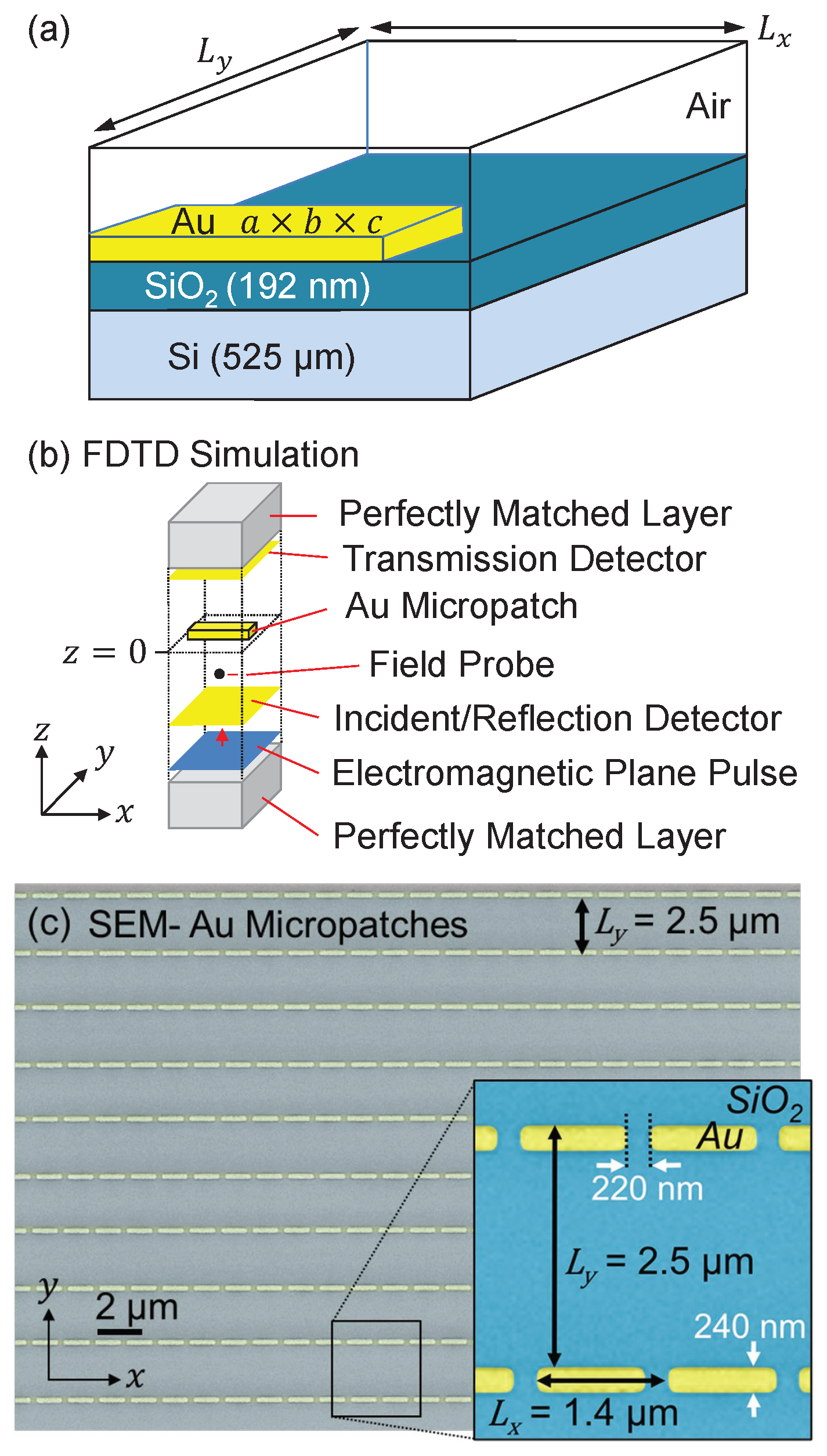
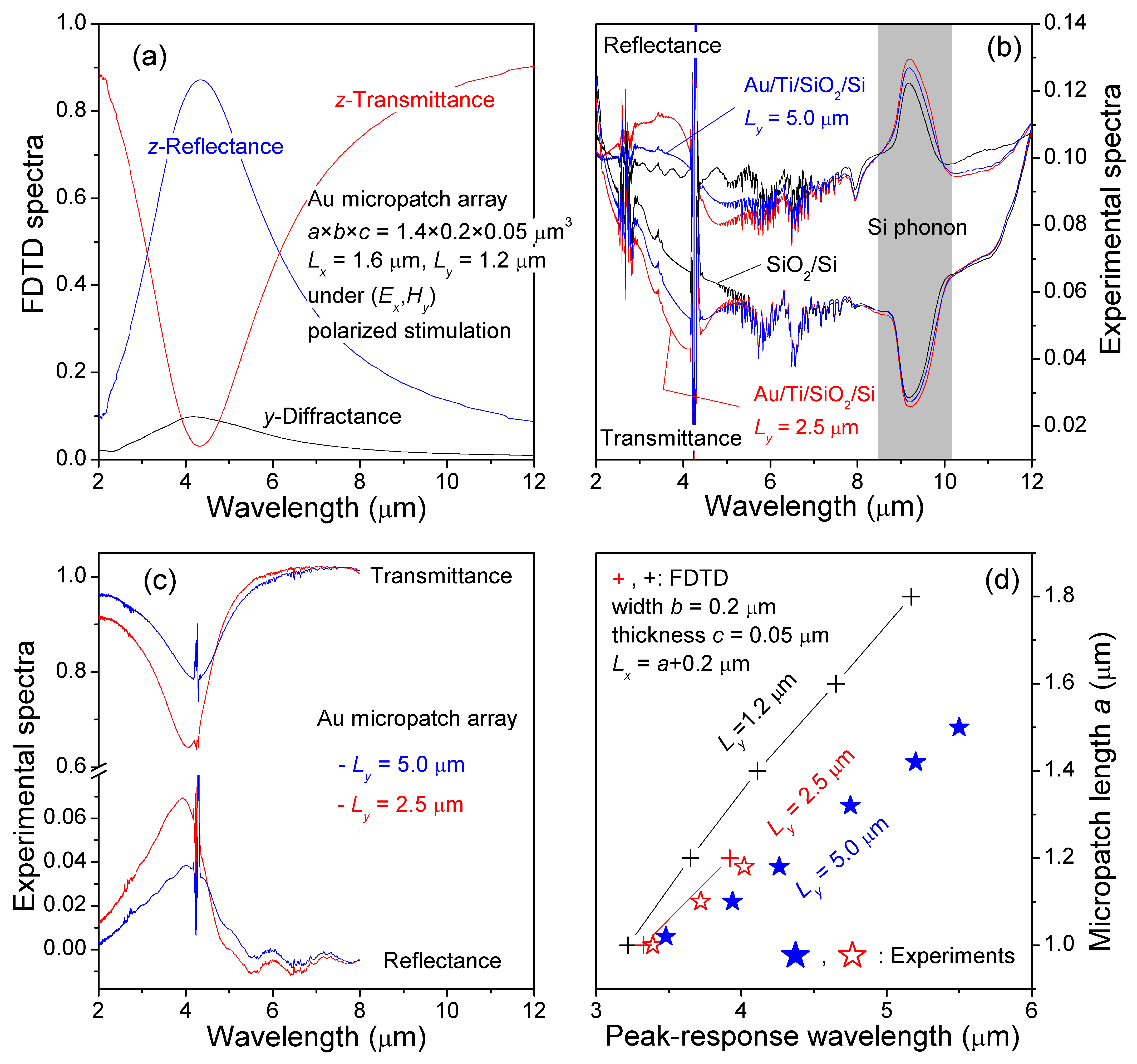
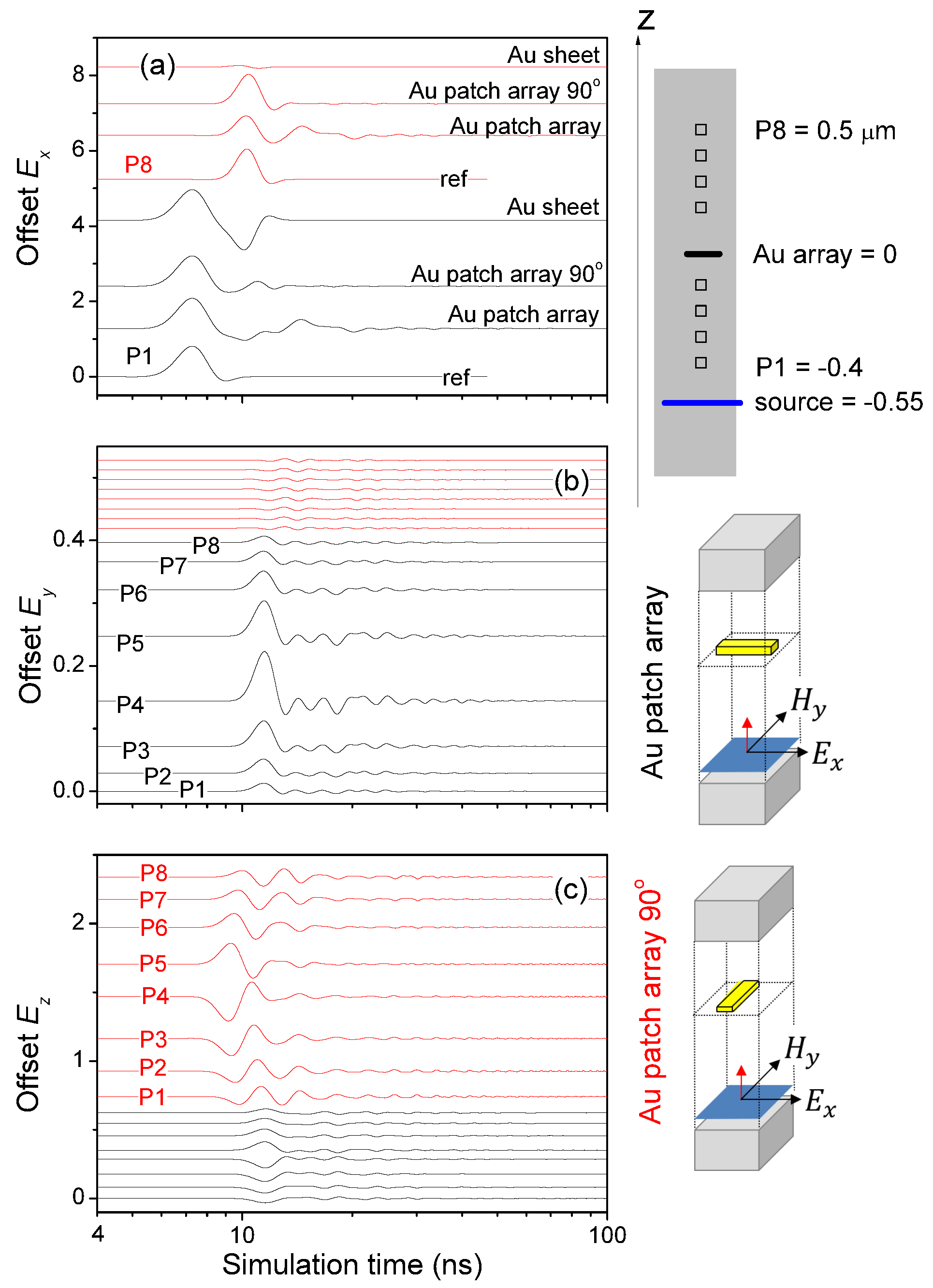
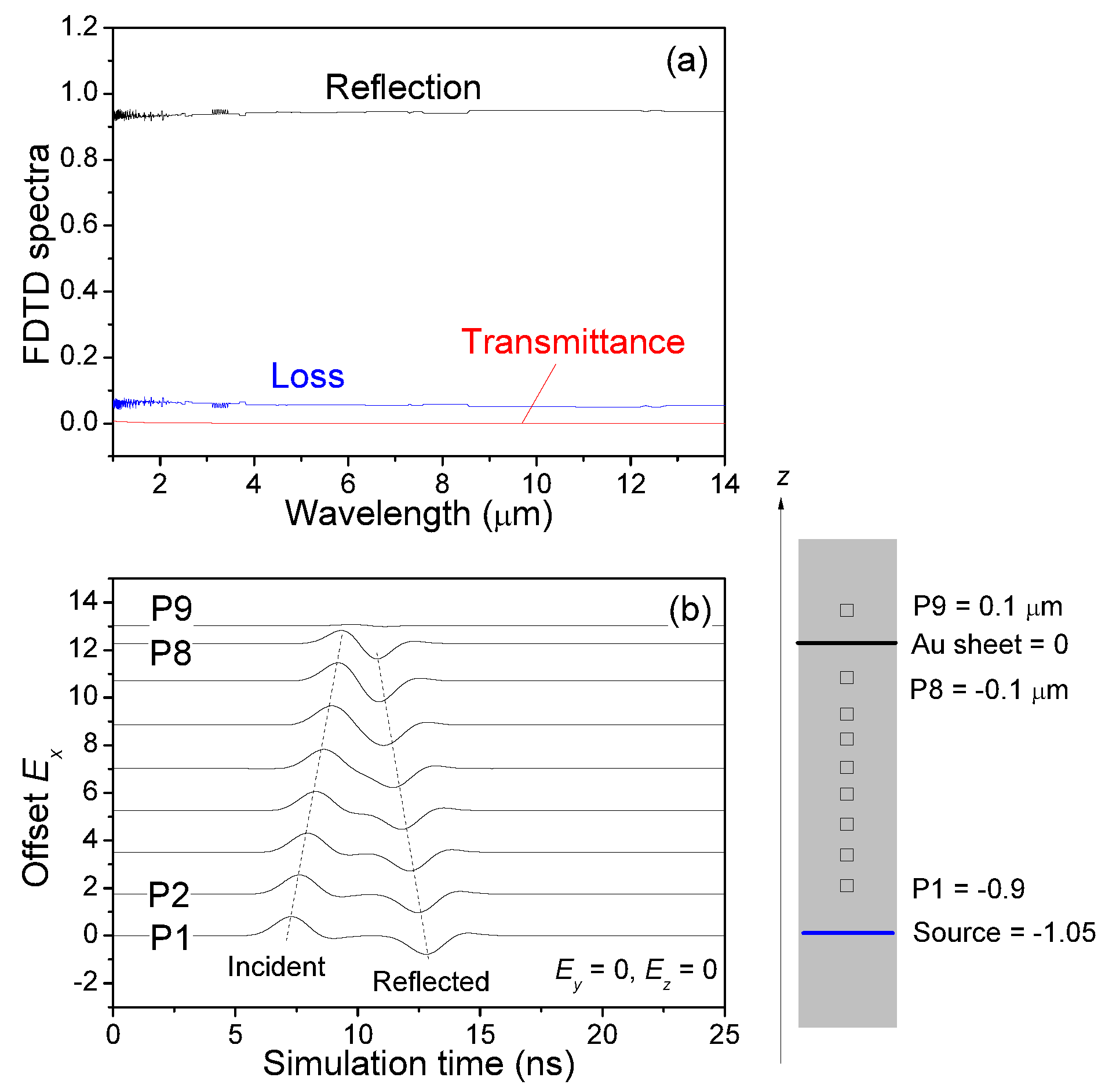
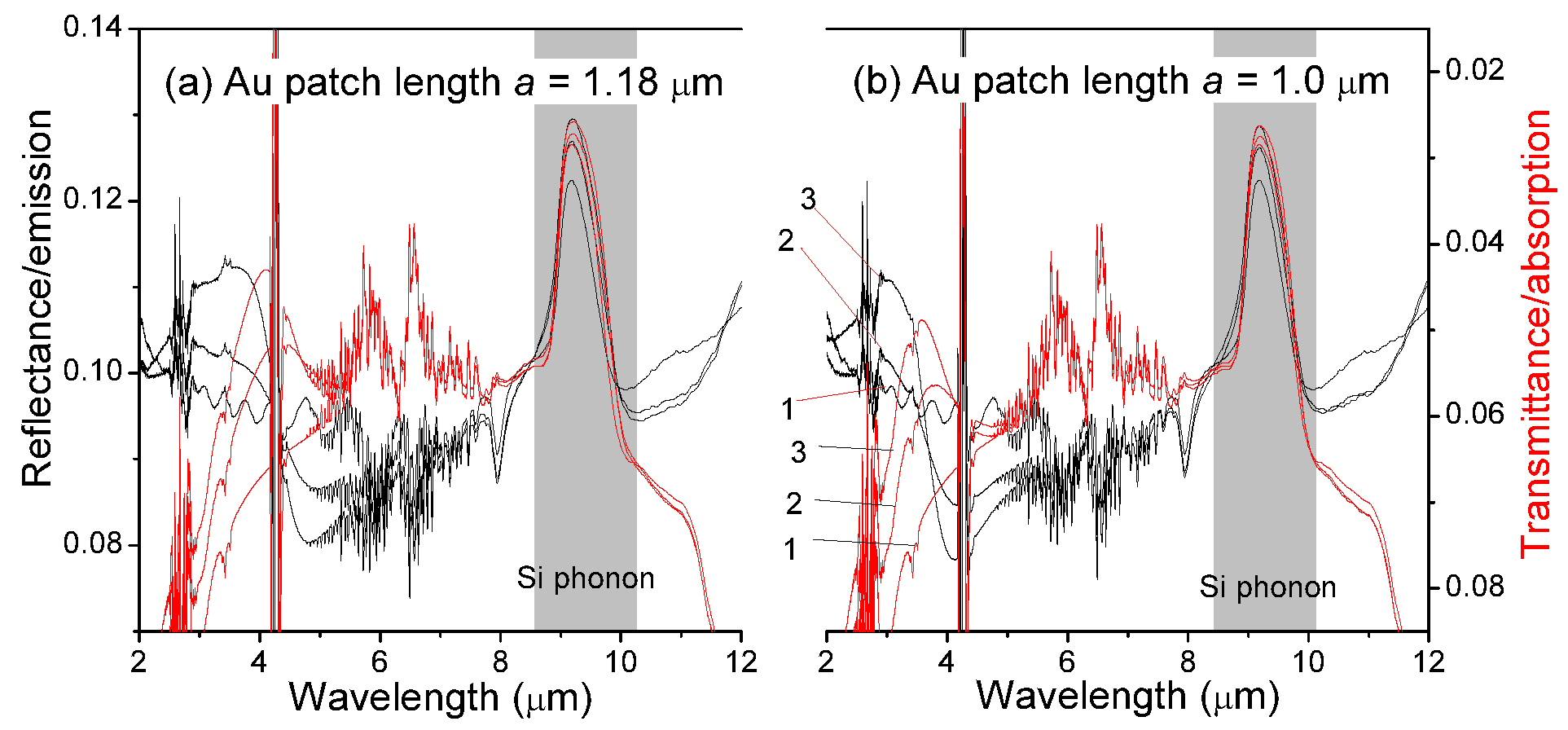
Publisher’s Note: MDPI stays neutral with regard to jurisdictional claims in published maps and institutional affiliations. |
© 2021 by the authors. Licensee MDPI, Basel, Switzerland. This article is an open access article distributed under the terms and conditions of the Creative Commons Attribution (CC BY) license (https://creativecommons.org/licenses/by/4.0/).
Share and Cite
Fu, Y.; Yager, T.; Chikvaidze, G.; Iyer, S.; Wang, Q. Time-Resolved FDTD and Experimental FTIR Study of Gold Micropatch Arrays for Wavelength-Selective Mid-Infrared Optical Coupling. Sensors 2021, 21, 5203. https://doi.org/10.3390/s21155203
Fu Y, Yager T, Chikvaidze G, Iyer S, Wang Q. Time-Resolved FDTD and Experimental FTIR Study of Gold Micropatch Arrays for Wavelength-Selective Mid-Infrared Optical Coupling. Sensors. 2021; 21(15):5203. https://doi.org/10.3390/s21155203
Chicago/Turabian StyleFu, Ying, Tom Yager, George Chikvaidze, Srinivasan Iyer, and Qin Wang. 2021. "Time-Resolved FDTD and Experimental FTIR Study of Gold Micropatch Arrays for Wavelength-Selective Mid-Infrared Optical Coupling" Sensors 21, no. 15: 5203. https://doi.org/10.3390/s21155203
APA StyleFu, Y., Yager, T., Chikvaidze, G., Iyer, S., & Wang, Q. (2021). Time-Resolved FDTD and Experimental FTIR Study of Gold Micropatch Arrays for Wavelength-Selective Mid-Infrared Optical Coupling. Sensors, 21(15), 5203. https://doi.org/10.3390/s21155203





